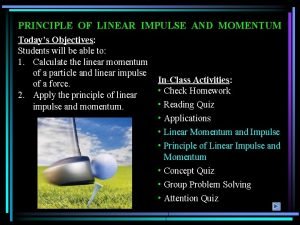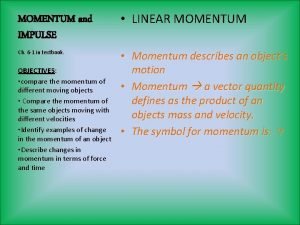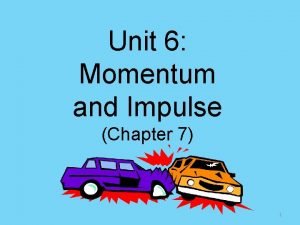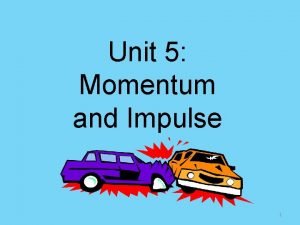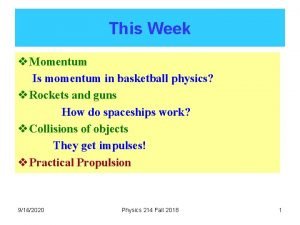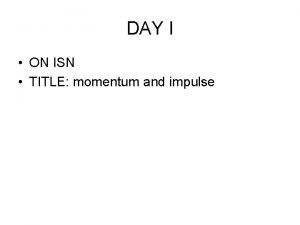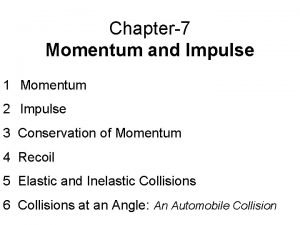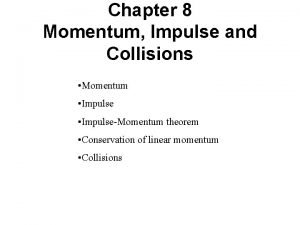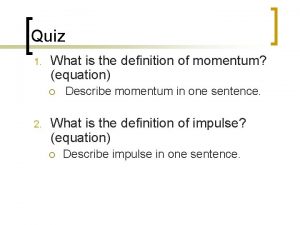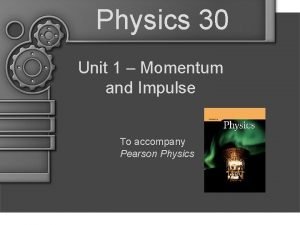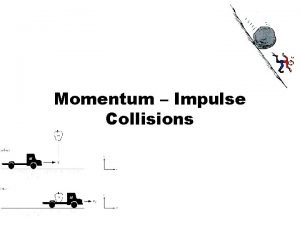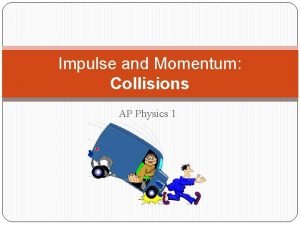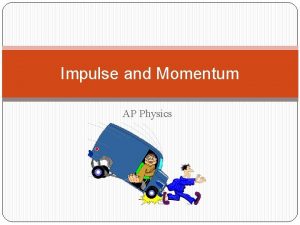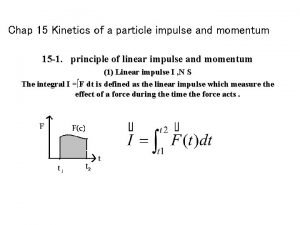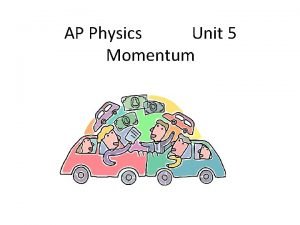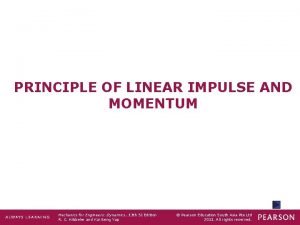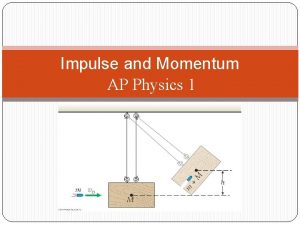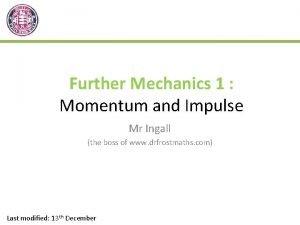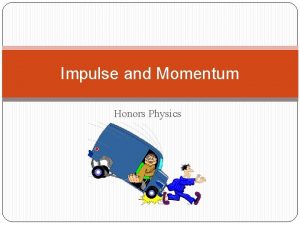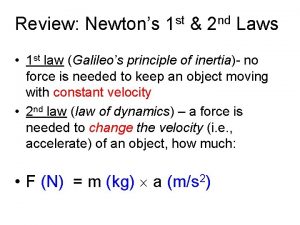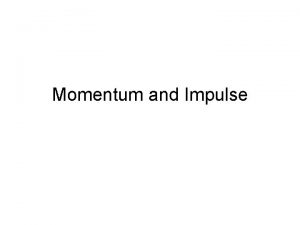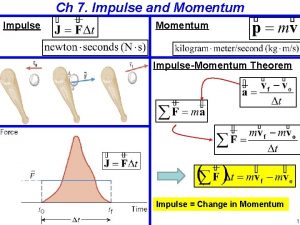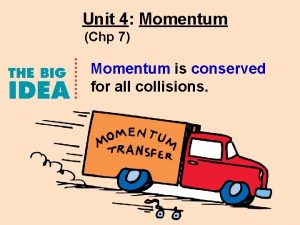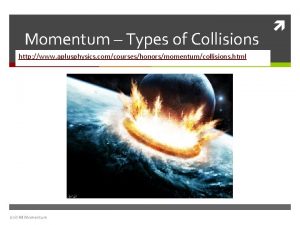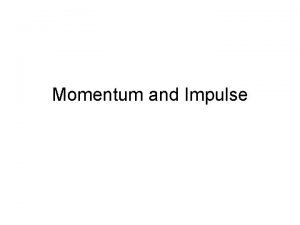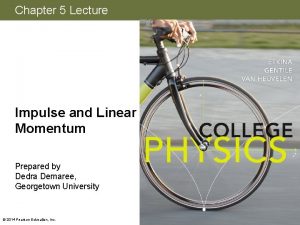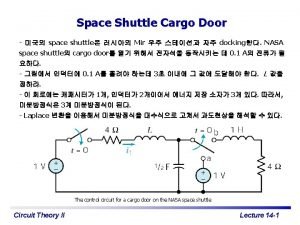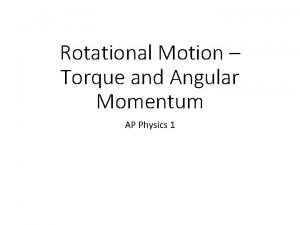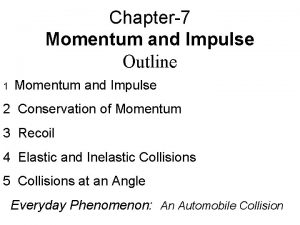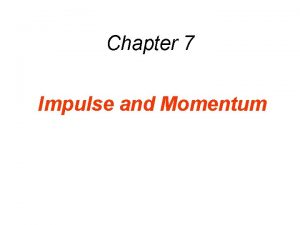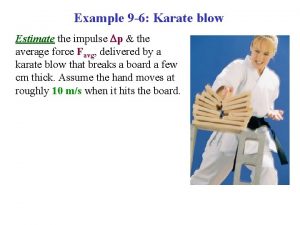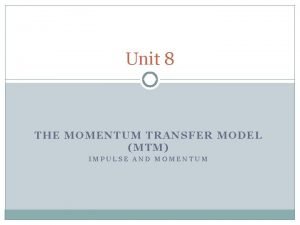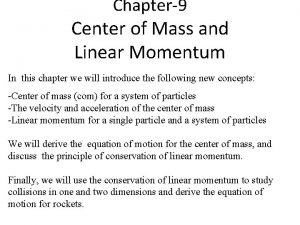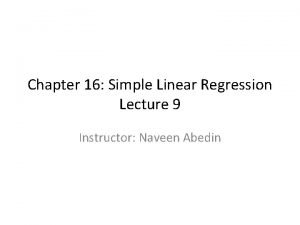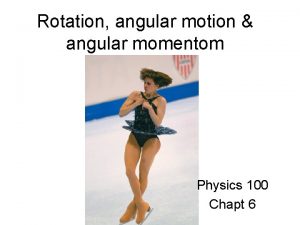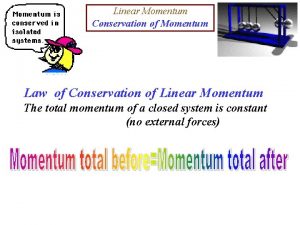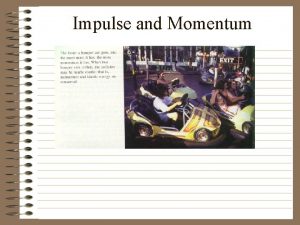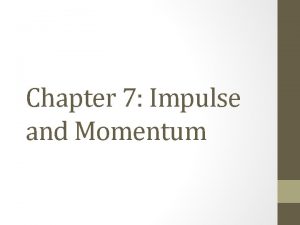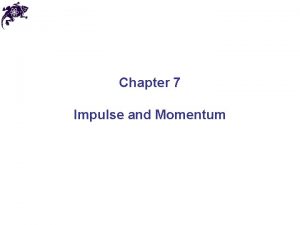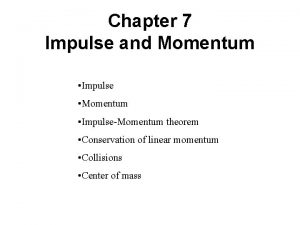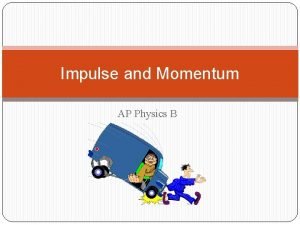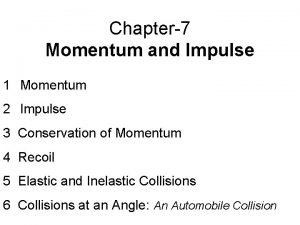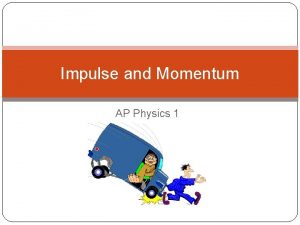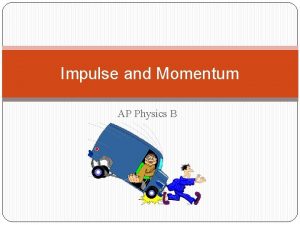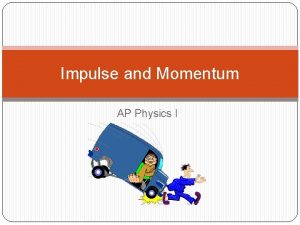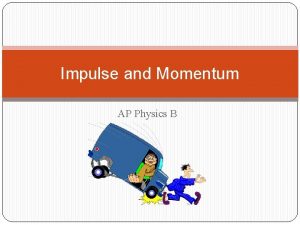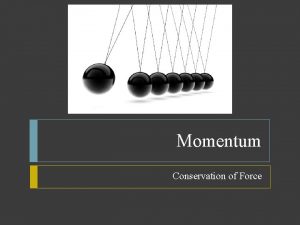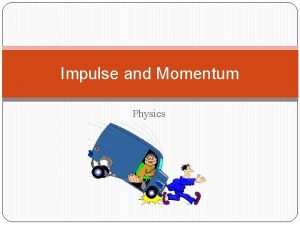Chapter 5 Lecture Impulse and Linear Momentum Prepared





















































- Slides: 53

Chapter 5 Lecture Impulse and Linear Momentum Prepared by Dedra Demaree, Georgetown University © 2014 Pearson Education, Inc.

Impulse and linear momentum • How does jet propulsion work? • How can you measure the speed of a bullet? • Would a meteorite collision significantly change Earth's orbit? © 2014 Pearson Education, Inc.

Be sure you know how to: • Construct a force diagram for an object (Section 2. 1). • Use Newton's second law in component form (Section 3. 2). • Use kinematics to describe an object's motion (Section 1. 7). © 2014 Pearson Education, Inc.

Where we are headed: • To use Newton's laws effectively, we need to know the forces that objects exert on each other. – If two cars collide, we don't know the force that one car exerts on the other during the collision. – When fireworks explode, we don't know the forces that are exerted on the pieces flying apart. • This chapter introduces a new approach that helps us analyze and predict mechanical phenomena when the forces are not known. © 2014 Pearson Education, Inc.

Mass accounting: Is the mass in a system always a constant value? • The mass of a log in a campfire decreases as the log burns. What happens to the "lost" mass from the log? • If we choose only the log as the system, the mass of the system decreases as it burns. • Air is needed for burning. What happens to the mass if we choose the surrounding air and the log as the system? © 2014 Pearson Education, Inc.

Mass accounting: Is the mass in a system always a constant value? © 2014 Pearson Education, Inc.

Law of constancy of mass • Lavoisier defined an isolated system as a group of objects that interact with each other but not with external objects. • When a system of objects is isolated (a closed container), its mass equals the sum of the masses of components and remains constant in time. • When the system is not isolated, any change in mass is equal to the amount of mass leaving or entering the system. © 2014 Pearson Education, Inc.

Accounting for changing mass • The mass is constant if there is no flow of mass in or out of the system. • The mass changes in a predictable way if there is some flow of mass between the system and the environment. © 2014 Pearson Education, Inc.

Mass bar chart • The left bar represents the initial mass of the system, the central bar represents the mass added or taken away, and the right bar represents the mass of the system in the final situation. • The height of the left bar plus the height of the central bar equals the height of the right bar. © 2014 Pearson Education, Inc.

Observational Experiment Table: Collisions in a system of two carts © 2014 Pearson Education, Inc.

Observational Experiment Table: Collisions in a system of two carts © 2014 Pearson Education, Inc.

Observational Experiment Table: Collisions in a system of two carts © 2014 Pearson Education, Inc.

Observational Experiment Table: Collisions in a system of two carts • One quantity remains the same before and after the collision in each experiment: the sum of the products of the mass and x-velocity component of the system objects. • Hypothesis to test: The sum of mass times velocity is the quantity characterizing motion that is constant in an isolated system. © 2014 Pearson Education, Inc.

Testing Experiment Table © 2014 Pearson Education, Inc.

Linear momentum © 2014 Pearson Education, Inc.

Important points about linear momentum • Linear momentum is a vector quantity; it is important to consider the direction in which the colliding objects are moving before and after the collision. • Momentum depends on the velocity of the object, and the velocity depends on the choice of the reference frame. Different observers will measure different momenta for the same object. • To establish that momentum is a conserved quantity, we need to ensure that the momentum of a system changes in a predictable way for systems that are not isolated. © 2014 Pearson Education, Inc.

Momentum constancy of an isolated system • For a system with more than two objects, we simply include a term on each side of the equation for each object in the system. © 2014 Pearson Education, Inc.

Example 5. 1: Two rollerbladers • Jen (50 kg) and David (75 kg), both on rollerblades, push off each other abruptly. Each person coasts backward at approximately constant speed. During a certain time interval, Jen travels 3. 0 m. • How far does David travel during that same time interval? © 2014 Pearson Education, Inc.

Importance of linear momentum • In the last example, we were able to determine the velocity by using the principle of momentum constancy. – We did not need any information about the forces involved. – This is a very powerful result, because in all likelihood the forces exerted were not constant. • The kinematics equations we have used assumed constant acceleration of the system (and thus constant forces). © 2014 Pearson Education, Inc.

Impulse due to a force exerted on a single object • We need a way to account for change in momentum when the net external force on a system is not zero • A relationship can be derived from Newton's laws and kinematics: © 2014 Pearson Education, Inc.

Two important points about impulse • This equation is Newton's second law written in a different form—one that involves the physical quantity momentum: • Both force and time interval affect momentum: a small force exerted over a long time interval can change the momentum of an object by the same amount as a large force exerted over a short time interval. © 2014 Pearson Education, Inc.

Impulse: The product of the external force exerted on an object and the time interval © 2014 Pearson Education, Inc.

Impulse-momentum equation for a single object • If the magnitude of the force changes during the time interval considered in the process, we use the average force. © 2014 Pearson Education, Inc.

Example 5. 2: Abrupt stop in a car • A 60 -kg person is traveling in a car that is moving at 16 m/s with respect to the ground when the car hits a barrier. The person is not wearing a seat belt, but is stopped by an air bag in a time interval of 0. 20 s. • Determine the average force that the air bag exerts on the person while stopping him. © 2014 Pearson Education, Inc.

Using Newton's laws to understand the constancy of momentum • Newton's third law provides a connection between our analyses of two colliding carts. • Interacting objects at each instant exert equal-magnitude but oppositely directed forces on each other: © 2014 Pearson Education, Inc.

The generalized impulse-momentum principle © 2014 Pearson Education, Inc.

Impulse-momentum bar charts © 2014 Pearson Education, Inc.

Impulse-momentum bar chart 1. Sketch the processes, choose the initial and final states, and choose a system. 2. Draw initial and final momentum bars for each object in the system. 3. Draw an impulse bar if there is an external nonzero impulse. 4. Convert each bar in the chart into a term in the component form of the impulse-momentum equation. © 2014 Pearson Education, Inc.

Impulse-momentum bar chart • The lengths of the bars are qualitative indicators of the relative magnitudes of the momenta. • The middle shaded column in the bar chart represents the net external impulse exerted on the system objects during the time interval. • The sum of the heights of the bars on the left plus the height of the shaded impulse bar should equal the sum of the heights of the bars on the right. • This "conservation of bar heights" reflects the conservation of momentum. © 2014 Pearson Education, Inc.

Using impulse-momentum to investigate forces • If we pick just one object in a collision as the system object, we can construct the bar chart for that object to find the impulse. • If we know the time interval of the collision, we know the average force exerted on the system object. © 2014 Pearson Education, Inc.

Tip • When you draw a bar chart, always specify the reference frame (the object of reference and the coordinate system). • The direction of the bars on the bar chart (up for positive and down for negative) should match the direction of the momentum or impulse based on the chosen coordinate system. © 2014 Pearson Education, Inc.

Example 5. 3: Happy and sad balls • You have two balls. One ball does not bounce; the other ball bounces back to almost the same height from which it was dropped. The balls are the same mass and size but are made of different materials. • You hang each ball from a string of identical length and place a wood board on its end directly below the support for each string. You pull each ball back to an equal height and release the balls one at a time. • When each ball hits the board, which has the best chance of knocking the board over? © 2014 Pearson Education, Inc.

Problem-solving strategy: Applying the impulse-momentum equation • Sketch and translate © 2014 Pearson Education, Inc.

Problem-solving strategy: Applying the impulse-momentum equation • Simplify and diagram © 2014 Pearson Education, Inc.

Problem-solving strategy: Applying the impulse-momentum equation • Represent mathematically © 2014 Pearson Education, Inc.

Problem-solving strategy: Applying the impulse-momentum equation • Solve and evaluate © 2014 Pearson Education, Inc.

Determining the stopping time interval from the stopping distance • Stopping distance is the distance it takes an object to stop during a collision. • It can often be measured after a collision, such as how far a car's front end crumples or the depth of a hole left by a meteorite. • Impulse-momentum tells us information about the stopping time; we must use kinematics to relate this to distance. © 2014 Pearson Education, Inc.

Determining the stopping time interval from the stopping distance © 2014 Pearson Education, Inc.

Example 5. 5: Stopping the fall of a movie stunt diver • The record for the highest movie stunt fall without a parachute is 71 m, held by 80 -kg A. J. Bakunas. His fall was stopped by a large air cushion, into which he sank about 4. 0 m. His speed was approximately 36 m/s when he reached the top of the air cushion. • Estimate the average force that the cushion exerted on this stunt diver's body while stopping him. © 2014 Pearson Education, Inc.

Example 5. 6: Bone fracture estimation • A bicyclist is watching for traffic from the left while turning toward the right. A street sign hit during an earlier car accident is bent over the side of the road. The cyclist's head hits the pole holding the sign. • Is there a significant chance that the cyclist's skull will fracture? © 2014 Pearson Education, Inc.

Jet propulsion • Cars change velocity because of an interaction with the road; a ship's propellers push water backward. • A rocket in empty space has nothing to push against. – If the rocket and fuel are at rest before the rocket fires its engines, the momentum is zero. Because there are no external impulses, after the rocket fires its engines, the momentum should still be zero. – Burning fuel is ejected backward at high velocity, so the rocket must have nonzero forward velocity. © 2014 Pearson Education, Inc.

Testing experiment: Rocket propulsion © 2014 Pearson Education, Inc.

Testing experiment: Rocket propulsion © 2014 Pearson Education, Inc.

Testing experiment: Rocket propulsion • Outcome: the velocity of the other rocket increases, and we see it move ahead of our rocket. • What can we conclude about our initial hypothesis? © 2014 Pearson Education, Inc.

Thrust • Thrust is the force exerted by the fuel on a rocket during jet propulsion. • Typical rocket thrusts measure approximately 106 N, and exhaust speeds are more than 10 times the speed of sound. • Thrust provides the impulse necessary to change a rocket's momentum. – The same principle is at work when you blow up a balloon, but then open the valve and release it, and when you stand on a skateboard with a heavy ball and throw the ball away from you. © 2014 Pearson Education, Inc.

Assumptions for jet propulsion • In reality, a rocket burns its fuel gradually rather than in one short burst; thus its mass is not a constant number but changes gradually. • To solve jet propulsion problems without calculus, we need to assume the fuel burns in a short enough burst to ignore the change in mass when the thrust is applied. © 2014 Pearson Education, Inc.

Example 5. 7: Meteorite impact • Arizona's Meteor Crater was produced 50, 000 years ago by the impact of a 3 x 108–kg meteorite traveling at 1. 3 x 104 m/s. The crater is approximately 200 m deep. • Estimate (1) the change in Earth's velocity as a result of the impact and (2) the average force exerted by the meteorite on Earth during the collision. © 2014 Pearson Education, Inc.

Tip • The choice of a system is motivated by the question being investigated. Always think about your goal when deciding what your system will be. © 2014 Pearson Education, Inc.

Example 5. 8: Radioactive decay of radon in lungs • An inhaled radioactive radon nucleus resides more or less at rest in a person's lungs, where it decays to a polonium nucleus and an alpha particle. The mass of the polonium nucleus is 54 times greater than the mass of the alpha particle. • With what speed does the alpha particle move if the polonium nucleus moves away at 4. 0 x 106 m/s relative to the lung tissue? © 2014 Pearson Education, Inc.

Example 5. 9: Collision in two dimensions • A 1600 -kg pickup truck traveling east at 20 m/s collides with a 1300 -kg car traveling north at 16 m/s. The vehicles remain tangled together after the collision. • Determine the velocity (magnitude and direction) of the combined wreck immediately after the collision. © 2014 Pearson Education, Inc.

Summary © 2014 Pearson Education, Inc.

Summary © 2014 Pearson Education, Inc.

Summary © 2014 Pearson Education, Inc.
 How to find maximum compression of a spring formula
How to find maximum compression of a spring formula Linear impulse momentum equation
Linear impulse momentum equation Which has a greater momentum a truck with a mass of 2250 kg
Which has a greater momentum a truck with a mass of 2250 kg Si unit of momentum
Si unit of momentum Physics 03-06 impulse and momentum answer key
Physics 03-06 impulse and momentum answer key Unit 6 momentum and impulse
Unit 6 momentum and impulse Units of momentum
Units of momentum Impulse and momentum in basketball
Impulse and momentum in basketball Importance of momentum and impulse
Importance of momentum and impulse Poem about momentum and impulse
Poem about momentum and impulse Importance of momentum and impulse
Importance of momentum and impulse Impulse momentum
Impulse momentum Momentum s.i unit
Momentum s.i unit Impulse and momentum in sports
Impulse and momentum in sports Impulse units
Impulse units Physics 30 momentum and impulse unit exam
Physics 30 momentum and impulse unit exam The momentum of an object at rest
The momentum of an object at rest Mel physics
Mel physics What has momentum
What has momentum Impulse law
Impulse law Impulse ap physics
Impulse ap physics Momentum
Momentum Kinetics of a particle: impulse and momentum
Kinetics of a particle: impulse and momentum Impulse and momentum
Impulse and momentum Dynamics impulse and momentum solved problems
Dynamics impulse and momentum solved problems Principle of angular impulse and momentum
Principle of angular impulse and momentum What is momentum in physics
What is momentum in physics Further mechanics 1 unit test 1 momentum and impulse
Further mechanics 1 unit test 1 momentum and impulse Type of collisions
Type of collisions Impulse and force
Impulse and force Momentum of center of mass formula
Momentum of center of mass formula Conceptual physics chapter 6 momentum
Conceptual physics chapter 6 momentum How does impulse relate to momentum
How does impulse relate to momentum The impulse-momentum relationship is a direct result of
The impulse-momentum relationship is a direct result of Types of collision
Types of collision Velocity mass formula
Velocity mass formula Momentum bar chart
Momentum bar chart Impulse invariant transformation
Impulse invariant transformation Theorem of angular momentum
Theorem of angular momentum A 2575 kg van runs into the back
A 2575 kg van runs into the back Impulse momentum
Impulse momentum Impulse momentum theorem definition
Impulse momentum theorem definition Impulse momentum change theorem
Impulse momentum change theorem Impulse momentum theorem egg drop
Impulse momentum theorem egg drop What is impulse
What is impulse Impulse momentum bar chart
Impulse momentum bar chart The impulse-momentum relationship is a direct result of
The impulse-momentum relationship is a direct result of 01:640:244 lecture notes - lecture 15: plat, idah, farad
01:640:244 lecture notes - lecture 15: plat, idah, farad Center of mass and linear momentum
Center of mass and linear momentum Elastic collison
Elastic collison The world of food and beverages chapter 4
The world of food and beverages chapter 4 Linear regression lecture
Linear regression lecture Angular quantities
Angular quantities Law of conservation of linear momentum
Law of conservation of linear momentum

